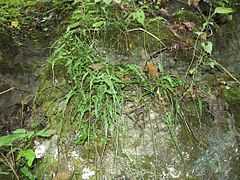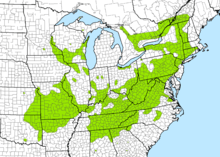Asplenium rhizophyllum
| Asplenium rhizophyllum | |
|---|---|
 | |
| Asplenium rhizophyllum on rocks in the Red River Gorge, Daniel Boone National Forest, Kentucky, USA. | |
| Conservation status | |
| Scientific classification | |
| Kingdom: | Plantae |
| Division: | Pteridophyta |
| Class: | Pteridopsida |
| Order: | Polypodiales |
| Family: | Aspleniaceae |
| Genus: | Asplenium |
| Species: | A. rhizophyllum |
| Binomial name | |
| Asplenium rhizophyllum L. | |
| Synonyms | |
|
Antigramma rhizophylla (L.) J.Sm. | |
Asplenium rhizophyllum, the American Walking Fern, is a frequently-occurring fern native to North America. It is a close relative of Asplenium ruprechtii[1] (syn: Camptosorus sibiricus) which is found in East Asia and also goes by the common name of "walking fern".[2]
Description
Asplenium rhizophyllum is a small fern whose undivided, evergreen leaves and long, narrow tips, sometimes curving back and rooting, give it a highly distinctive appearance.
Roots and stipes
It does not spread and form new plants via the roots. The rhizome bears dark brown, narrowly triangular scales 2 to 3 millimetres (0.08 to 0.1 in) long and 0.5 to 1 millimetre (0.02 to 0.04 in) wide (occasionally as narrow as 0.2 millimetres (0.008 in)) with untoothed margins. The stipe (the part of the stem below the leaf blade) is 0.5 to 12 centimetres (0.20 to 4.7 in) long, and ranges from one-tenth to one and one-half times the length of the blade. The stipe is reddish-brown at the base, becoming green above. Scales like those of the rhizome are present at the stipe base, changing to tiny club-shaped hairs above.[1]
Leaves
The leaf blades are not subdivided, as in most other ferns, but are narrowly triangular to linear or lance-shaped. Their shape can be quite variable, even on the same plant. They measure from 1 to 30 centimetres (0.4 to 10 in) long and from 0.5 to 5 centimetres (0.2 to 2 in) across and have a leathery texture with sparse hairs, more abundant below than above. The rachis (leaf axis) is dull green in color and almost devoid of hairs. On the underside of the blade, the veins are difficult to see and anastomose (split and rejoin each other), forming a series of areoles (the small areas enclosed by the veins) near the rachis. Fertile fronds are usually larger than sterile fronds, but their shape is otherwise the same. The base of the blade is typically heart-shaped (with the stipe protruding from the cleft); the bulges on either side of the cleft are frequently enlarged into auricles (rounded lobes), or occasionally into sharply-pointed, tapering lobes. The leaf tips may be rounded but are typically very long and attenuate (drawn out); the attenuate tips are capable of sprouting roots and growing into a new plant when the tip touches a surface suitable for growth. On rare occasions, the auricles at the leaf base will also take on an attenuate shape and form roots at the tip.[1] The ability of the leaf tips to root and form a new plant at some distance from the parent gives the species its common name.
Sori and spores
Fertile fronds bear a large number of sori underneath, which are not arranged in any particular order. The sori are often fused where veins join. Each sporangium in a sorus carries 64 spores. The diploid sporophyte has a chromosome number of 72.[1]
Similar species
The leaf shape and proliferating tips easily distinguish A. rhizophyllum from most other ferns. Its hybrid descendants share the long-attenuate leaf tip, but are more deeply lobed. An artificial backcross between A. rhizophyllum and A. tutwilerae was closer to A. rhizophyllum in morphology, but still remained some lobes in the basal part of the blade, showed a maroon color in the stipe up to the base of the leaf blade, and possessed the abortive spores of a sterile hybrid.[3] A. ruprechtii, the Asian walking fern, also possesses attenuate, proliferating tips, but has a lanceolate leaf blade, which tapers to a wedge at the base rather than forming a heart shape.[4]
The profile of the plant is usually not more than 5 cm (2 inches) in height, but can be up to 15 cm (6 inches) high.
Taxonomy
Linnaeus first gave the walking fern the binomial Asplenium rhizophyllum in his Species Plantarum of 1753.[5] J.H.F. Link placed the species in a segregate genus, Camptosorus, because of the irregular arrangement of its sori (in contrast to the rest of Asplenium, where the sori are confined to the edge of veins).[6] John Smith did not feel that this character was sufficient to segregate it from the rest of Asplenium, but placed it in the genus Antigramma, another Asplenium segregate, on the basis of its reticulate venation, to the convolutions of which he attributed the soral arrangement.[7] It was commonly placed either in Asplenium and Camptosorus by later authors,[1] but phylogenetic studies have shown that Camptosorus is nested within Asplenium and its species should be treated as part of that genus.[8][9]
Hybrids
The walking fern is one of the parents of the hybrid-derived species Asplenium pinnatifidum (see Asplenium hybrids), also known as the lobed spleenwort. A. montanum, the mountain spleenwort, is the other parent. It also frequently hybridizes with the ebony spleenwort, Asplenium platyneuron to form the Scott's spleenwort, Asplenium × ebenoides. At one locality, in Havana Glen, Alabama, A. × ebenoides has undergone chromosome doubling to produce a fertile species, Tutwiler's spleenwort (A. tutwilerae).[10]
Distribution and habitat

This fern grows on alkaline to sub-acid rock, always in a moss bed. It is seen to best effect on limestone boulders and ledges, although it also grows on sandstone.
Citations
- ↑ 1.0 1.1 1.2 1.3 1.4 Wagner, Moran & Werth 1993.
- ↑ Encyclopædia Britannica Online
- ↑ Wagner & Boydston 1958.
- ↑ Lin & Viane 2013.
- ↑ Linnaeus 1753, p. 1078.
- ↑ Link 1833, p. 69.
- ↑ Smith 1842, pp. 176–177.
- ↑ Murakami et al. 1999.
- ↑ Schneider et al. 2004.
- ↑ Wagner 1954.
Bibliography
- Lin, Youxing; Viane, Ronald (2013). Flora of China Editorial Committee, ed. Asplenium ruprechtii. Flora of China 2–3 (Science Press, Beijing and Missouri Botanical Garden Press).
- Link, Heinrich Friedrich (1833). Hortus Regius Botanicus Berolinensis 2. Berlin: G. Reimer.
- Linnaeus, C. (1753). Species Plantarum II.
- Murakami, Noriaki; Nogami, Satoru; Watanabe, Mikio; Iwatsuki, Kunio (1999). "Phylogeny of Aspleniaceae inferred from rbcL nucleotide sequences". American Fern Journal 89: 232–243. doi:10.2307/1547233.
- Schneider, Harald; Russell, Steve J.; Cox, Cymon J.; Bakker, Freek; Henderson, Sally; Rumsey, Fred; Barrett, John; Gibby, Mary; Vogel, Johannes C. (2004). "Chloroplast Phylogeny of Asplenioid Ferns based on rbcL and trnL-F Spacer Sequences (Polypodiidae, Aspleniaceae) and its Implications for Biogeography". Systematic Botany 29 (2): 260–274. doi:10.1600/036364404774195476.
- Smith, John (1842). "An arrangement and definition of the Genera of Ferns". Hooker's Journal of Botany 4: 147–198.
- Wagner, Warren H., Jr. (1954). "Reticulate Evolution in the Appalachian Aspleniums". Evolution 8: 103–118. doi:10.2307/2405636.
- Wagner, Warren H. Jr.; Boydston, Kathryn E. (1958). "A new hybrid spleenwort from artificial cultures at Fernwood and its relationship to a peculiar plant from West Virginia". American Fern Journal 48 (4): 146–159. doi:10.2307/1545451.
- Wagner, Warren H., Jr.; Moran, Robbin C.; Werth, Charles R. (1993). Flora of North America Editorial Committee, ed. Asplenium rhizophyllum. Flora of North America North of Mexico 2 (New York and Oxford: Oxford University Press).
